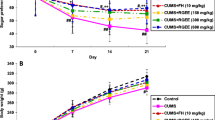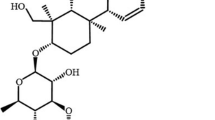Abstract
3-n-Butylphthalide (NBP), an extract from seeds of Apium graveolens Linn. (Chinese celery), has been demonstrated to have antidepressant effects in suspension chronic-stressed rats by our group. The purpose of this study was to investigate the possible involvement of brain-derived neurotrophic factor (BDNF) and mammalian target of rapamycin (mTOR) in the antidepressant mechanism of NBP. Chronic unpredictable mild stress (CUMS) was applied for 6 weeks to induced a depressive-like behavior, characterized by decreased locomotor activity, sucrose preference and the NE, DA and 5-HT levels in cortex. Oral treatment with NBP (30 or 100 mg/kg, p.o.), similarly to fluoxetine (2 mg/kg, p.o.), can prevention of these alterations. The NBP (30 or 100 mg/kg, p.o.) reversed the decrease in the BDNF, p-ERK, mTOR and synapsin-1 protein levels in rat cortex caused by CUMS. And rapamycin, an mTOR inhibitor, completely inhibited the antidepressant-like activity of NBP in vivo. In conclusion, these findings indicate that NBP treatment attenuated the depression-like behaviors through the modulation of serotonergic system and BDNF-ERK-mTOR signaling in rat.









Similar content being viewed by others
References
Greenberg PE, Fournier AA, Sisitsky T, Pike CT, Kessler RC (2015) The economic burden of adults with major depressive disorder in the United States (2005 and 2010). J Clin Psychiatry 76:155–162. https://doi.org/10.4088/JCP.14m09298
Bostwick JM (2010) A generalist’s guide to treating patients with depression with an emphasis on using side effects to tailor antidepressant therapy. Mayo Clin Proc 85:538–550. https://doi.org/10.4065/mcp.2009.0565
Jasiak NM, Bostwick JR (2014) Risk of QT/QTc prolongation among newer non-SSRI antidepressants. Ann Pharmacother 48:1620–1628. https://doi.org/10.1177/1060028014550645
Ma S, Xu S, Liu B, Li J, Feng N, Wang L, Wang X (2009) Long-term treatment of l-3-n-butylphthalide attenuated neurodegenerative changes in aged rats. Naunyn Schmiedebergs Arch Pharmacol 379:565–574. https://doi.org/10.1007/s00210-009-0398-8
Liu CL, Liao SJ, Zeng JS, Lin JW, Li CX, Xie LC, Shi XG, Huang RX (2007) dl-3n-Butylphthalide prevents stroke via improvement of cerebral microvessels in RHRSP. J Neuro Sci 260:106–113. https://doi.org/10.1016/j.jns.2007.04.025
Peng Y, Xing C, Lemere CA, Chen G, Wang L, Feng Y, Wang X (2008) 1-3-n-Butylphthalide ameliorates beta-amyloid-induced neuronal toxicity in cultured neuronal cells. Neurosci Lett 434:224–229. https://doi.org/10.1016/j.neulet
Yan C, Feng Y, Zhang J (1998) Effects of dl-3-n-butylphthalide on regional cerebral blood flow in right middle cerebral artery occlusion rats. Acta Pharmacol Sin 01:36–39. https://doi.org/10.1016/S0168-3659(97)00217-4
Peng Y, Zeng X, Feng Y, Wang X (2004) Antiplatelet and antithrombotic activity of l-3-n-butylphthalide in rats. J Cardiovasc Pharmacol 43:876–881. https://doi.org/10.1097/00005344-200406000-00018
Ye J, Zhai L, Zhang S, Zhang Y, Chen L, Hu L et al (2015) dl-3-n-Butylphthalide inhibits platelet activation via inhibition of cPLA2-mediated TXA2 synthesis and phosphodiesterase. Platelets 26:736–744. https://doi.org/10.3109/09537104.2014.989826
Wang Y, Qi W, Zhang L, Ying Z, Sha O, Li C et al (2017) The novel targets of dl-3-n-butylphthalide predicted by similarity ensemble approach in combination with molecular docking study. Quant Imaging Med Surg 7:532–536. https://doi.org/10.21037/qims.2017.10.08
Ji X-C, Zhao W-H, Cao D-X, Shi Q-Q (2011) Novel neuroprotectant chiral 3-n-butylphthalide inhibits tandem-pore-domain potassium channel TREK-1. Acta Pharmacol Sin 32:182–187
Xu LL, Wang XY, Zhang XY (2016) Antidepression effect of 3-n-Butylphathlide in mice and rat. J Yichun Univ 38:23–27
Phillips C (2017) Brain-derived neurotrophic factor, depression, and physical activity: making the neuroplastic connection. Neural Plast 2017:7260130. https://doi.org/10.1155/2017/7260130
Laplante M, Sabatini DM (2009) mTOR signaling at a glance. Cell Sci 122:3589–3594. https://doi.org/10.1242/jcs.035105
Duman RS, Li NX, Liu RJ, Duric V, Aghajanian G (2012) The mTOR Signaling pathways underlying the rapid antidepressant actions of ketamine. Neuropharmacology 62:35–41. https://doi.org/10.1016/j.neuropharm.2011.08.044
Zhou W, Wang N, Yang C, Li XM, Zhou ZQ, Yang JJ (2014) Ketamine-induced antidepressant effects are associated with AMPA receptors-mediated upregulation of mTOR and BDNF in rat hippocampus and prefrontal cortex. Eur Psychiatry 29:419–423. https://doi.org/10.1016/j.eurpsy.2013.10.005
Willner P (1997) Validity, reliability and utility of the chronic mild stress model of depression: a 10-year review and evaluation. Psychopharmacology 134:319–329. https://doi.org/10.1007/s002130050456
Kulkarni SK, Dandiya PC (1973) Effect of antidepressant agents on open field behaviour in rats. Psychopharmacologia 33:333–338. https://doi.org/10.1007/BF00437510
Willner P, Muscat R, Papp M (1992) Chronic mild stress-induced anhedonia: a realistic animal model of depression. Neurosci Biobehav Rev 16:525–534. https://doi.org/10.1016/s0149-7634(05)80194-0
Zhang Y, Wang HB, Yang HX, Chen Q, Zhao L (2010) Content determination of monoamine neurotransmitter in different encephalic regions in rat by fluorospectrophotometry. J Northeast Agric Univ 41:93–96. https://doi.org/10.3788/gzxb20103904.0680
Trivedi MH, Rush AJ, Wisniewski SR, Nierenberg AA, Warden D, Ritz L, Norquist G, Howland RH, Lebowitz B, McGrath PJ, Shores-Wilson K, Biggs MM, Balasubramani GK, Fava M (2006) Evaluation of outcomes with citalopram for depression using measurement based care in STAR*D: implications for clinical practice. Am J Psychiatry 163:28–40. https://doi.org/10.1176/appi.ajp.163.1.28
Rush AJ, Trivedi MH, Wisniewski SR, Nierenberg AA, Stewart JW, Warden D, Niederehe G, Thase ME, Lavori PW, Lebowitz BD, McGrath PJ, Rosenbaum JF, Sackeim HA, Kupfer DJ, Luther J, Fava M (2006) Acute and longer-term outcomes in depressed outpatients requiring one or several treatment steps: a STAR*D report. Am J Psychiatry 163:1905–1917. https://doi.org/10.1176/ajp.163.11.1905
Vollmayr B, Henn FA (2003) Stress models of depression. Clin Neurosci Res 3:245–251. https://doi.org/10.1016/S1566-2772(03)00086-0
Krishnan V, Nestler EJ (2008) The molecular neurobiology of depression. Nature 455:894–902. https://doi.org/10.1038/nature07455
Zhang F, Shao J, Tian J, Zhong Y, Ye L, Meng X, Liu Q, Wang H (2016) Antidepressant-like effects of LPM580153, a novel potent triple reuptake inhibitor. Sci Rep 6:24233. https://doi.org/10.1038/srep24233
Arumugam V, John VS, Augustine N, Jacob T, Joy SM, Sen S, Sen T (2017) The impact of antidepressant treatment on brain-derived neurotrophic factor level: an evidence-based approach through systematic review and meta-analysis. Indian J Pharmacol 49:236–242. https://doi.org/10.4103/ijp.IJP_700_16
Castrén E, Rantamäki T (2010) The role of BDNF and its receptors in depression and antidepressant drug action: reactivation of developmental plasticity. Dev Neurobiol 70:289–297. https://doi.org/10.1002/dneu.20758
Castren E, Voikar V, Rantamaki T (2007) Role of neurotrophic factors in depression. Curr Opin Pharmacol 7:18–21. https://doi.org/10.1016/j.coph.2006.08.009
Kong SY, Li QF, Yang J, He L (2007) The effect of Butylphthalide on expression of NGF and BDNF in ischemia stroke tissue of rat cerebrum. Sichuan Da Xue Xue Bao (Medical Science Edition) 38:400–403
Autry AE, Adachi M, Nosyreva E, Na ES, Los MF, Cheng PF, Kavalali ET, Monteggia LM (2011) NMDA receptor blockade at rest triggers rapid behavioural antidepressant responses. Nature 475:91–95. https://doi.org/10.1038/nature10130
Jourdi H, Hsu YT, Zhou M, Qin Q, Bi X, Baudry M (2009) Positive AMPA receptor modulation rapidly stimulates BDNF release and increases dendritic mRNA translation. J Neurosci 29:8688–8697. https://doi.org/10.1523/JNEUROSCI.6078-08.2009
Spencer JL, Waters EM, Milner TA, Lee FS, McEwen BS (2010) BDNF variant Val66Met interacts with estrous cycle in the control of hippocampal function. Proc Natl Acad Sci USA. https://doi.org/10.1073/pnas.0915105107
Li N, Lee B, Liu RJ, Banasr M, Dwyer JM, Iwata M, Li XY, Aghajanian G, Duman RS (2010) mTOR-dependent synapse formation underlies the rapid antidepressant effects of NMDA antagonists. Science 329:959–964. https://doi.org/10.1126/science.1190287
Funding
This study was supported by the National Natural Science Foundation of China (Grant No. 81560584).
Author information
Authors and Affiliations
Corresponding author
Ethics declarations
Conflict of interest
The authors have no conflicts of interest to declare.
Additional information
Publisher's Note
Springer Nature remains neutral with regard to jurisdictional claims in published maps and institutional affiliations.
Rights and permissions
About this article
Cite this article
Chen, C., Ma, H. & Fu, Z. Antidepressant-like Effect of 3-n-Butylphthalide in Rats Exposed to Chronic Unpredictable Mild Stress: Modulation of Brain-Derived Neurotrophic Factor Level and mTOR Activation in Cortex. Neurochem Res 46, 3075–3084 (2021). https://doi.org/10.1007/s11064-021-03397-9
Received:
Revised:
Accepted:
Published:
Issue Date:
DOI: https://doi.org/10.1007/s11064-021-03397-9




